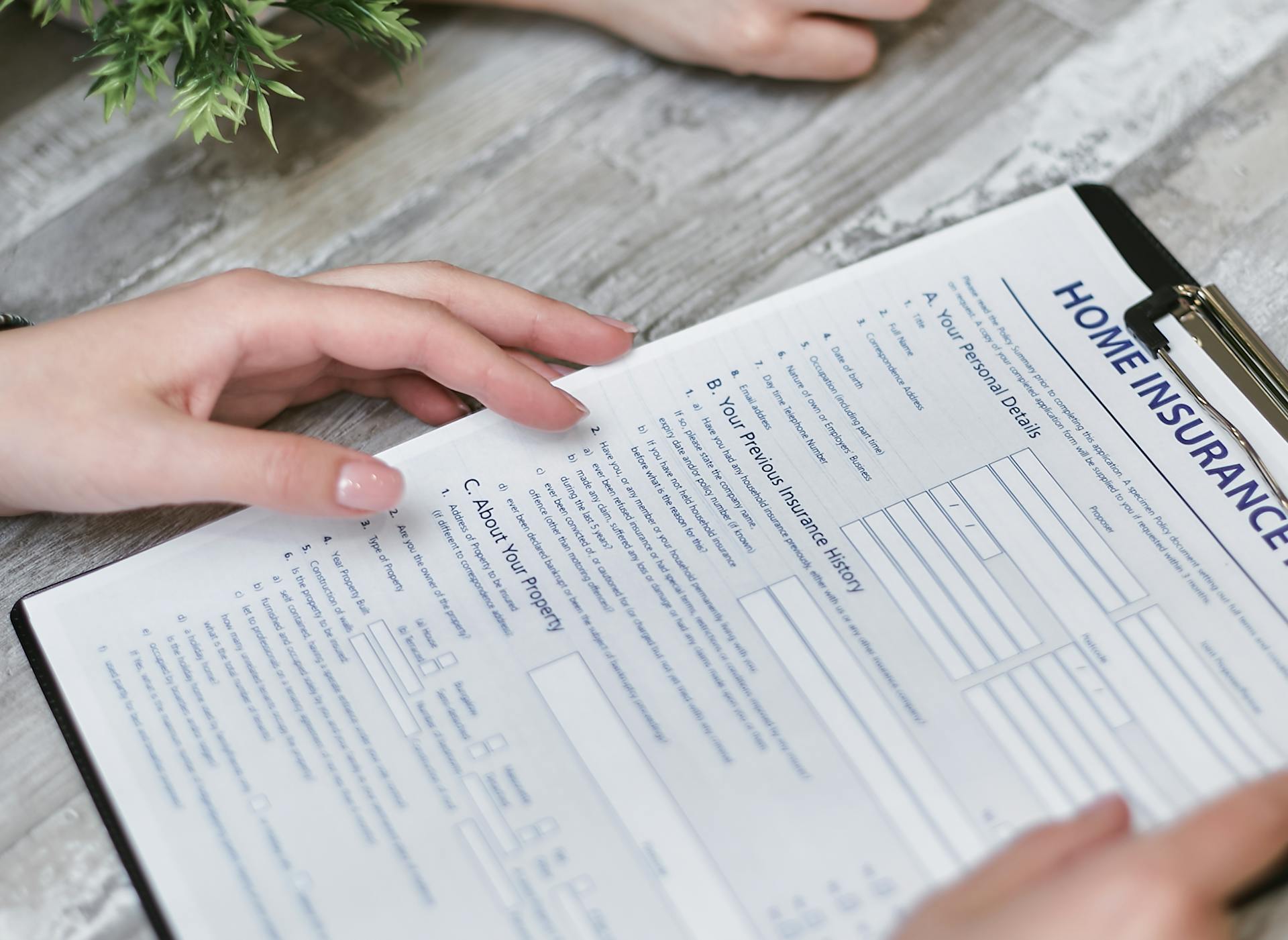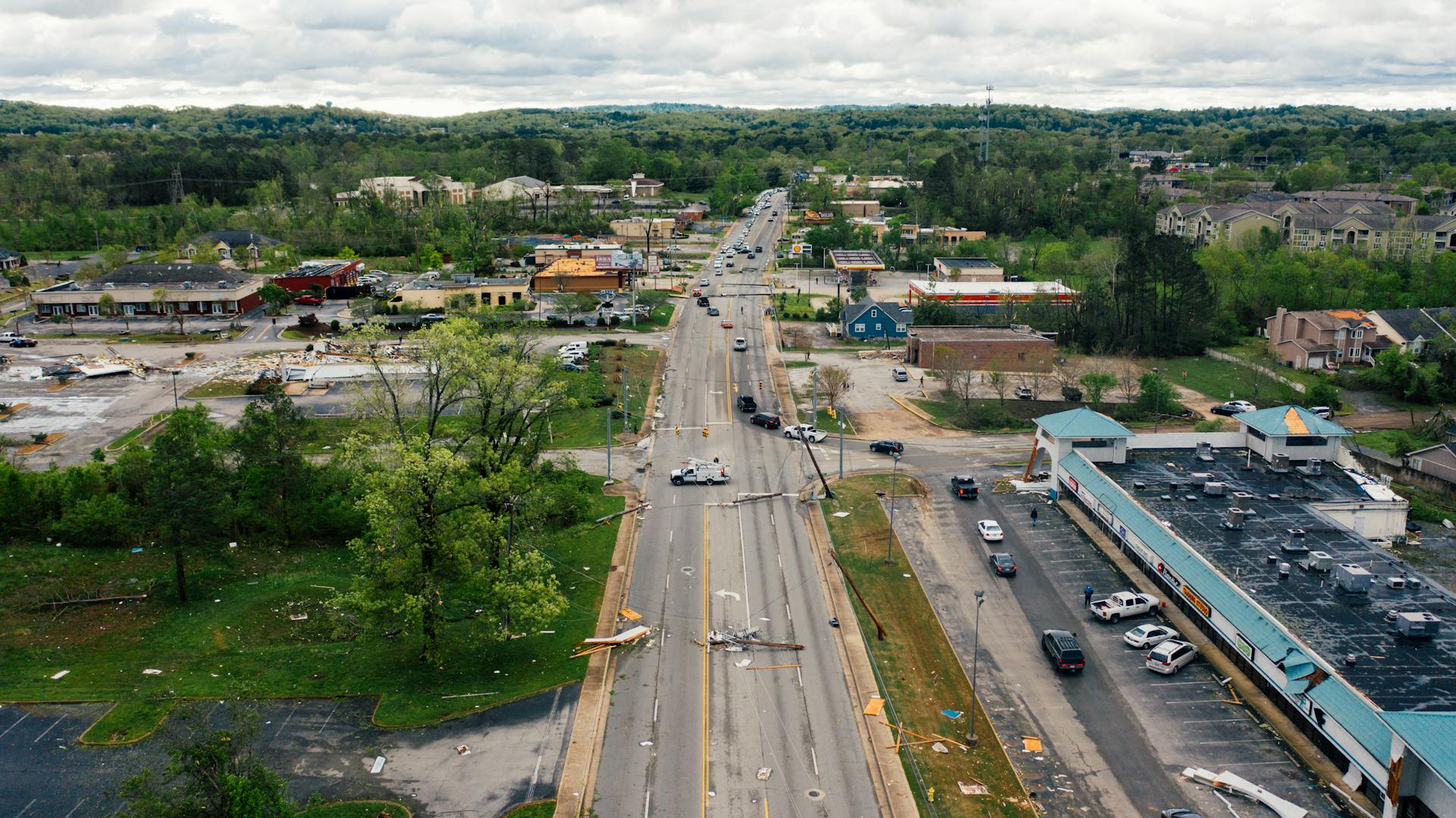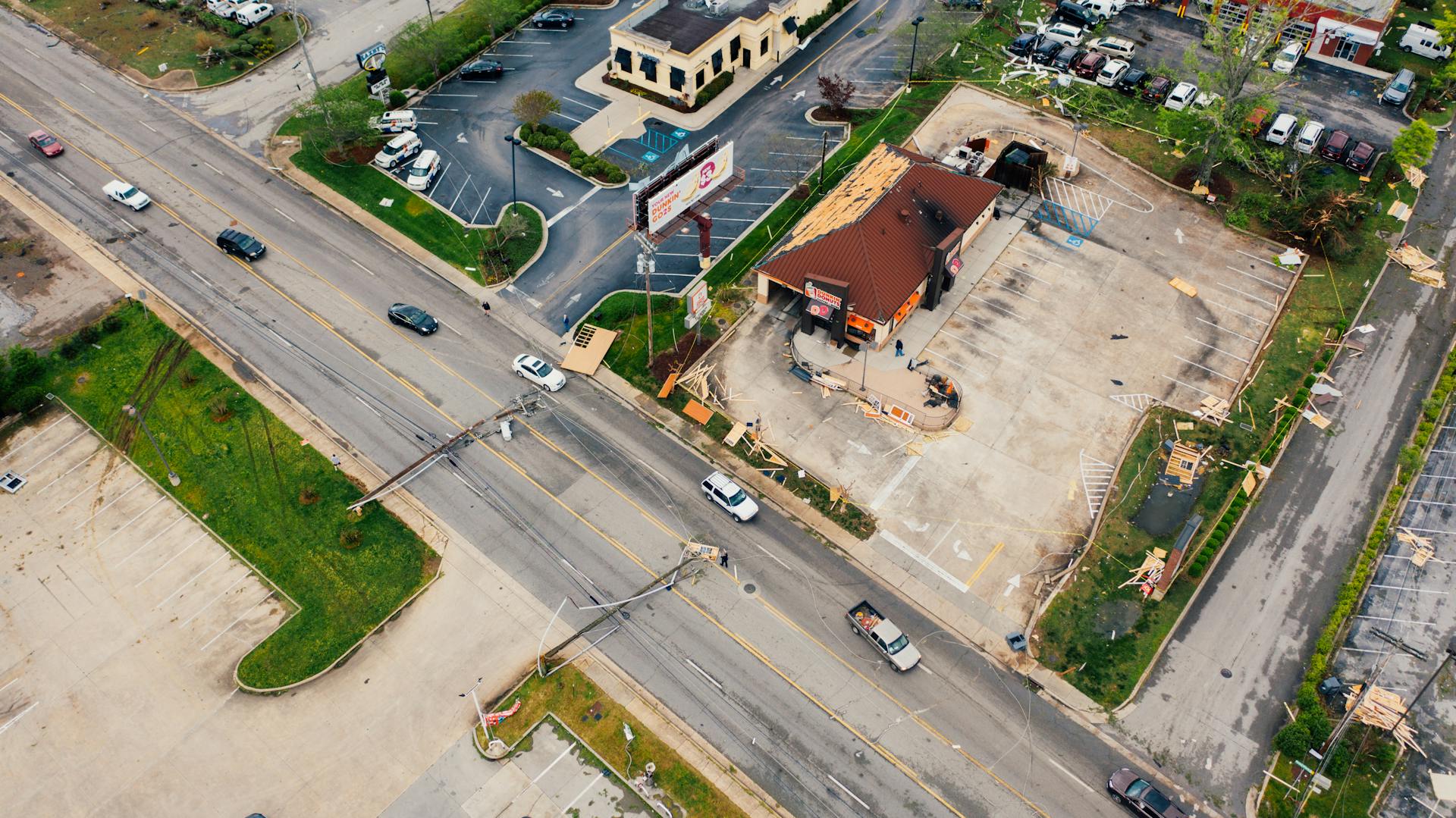
Storms can be devastating, causing extensive damage to your home and belongings. Most standard home insurance policies cover damage caused by windstorms, hail, and lightning.
However, it's essential to review your policy to understand what's covered and what's not. Some policies may have specific exclusions or limitations for certain types of storm damage.
A typical home insurance policy may cover damage to your home's roof, walls, and windows, as well as damage to personal property like furniture and appliances. But it's crucial to check your policy to see if there are any specific requirements for filing a claim after a storm.
If your home is damaged in a storm, you'll need to document the damage thoroughly, including taking photos and videos, and keeping receipts for any temporary repairs or accommodations.
Understanding Home Insurance
Home insurance policies provide financial protection from windstorm damage, covering your dwelling, detached units, personal property, and living expenses if you're displaced. This is a standard offering from most homeowners policies.
However, in some more hurricane-prone areas, wind may not be considered a covered peril, and you'd need separate wind insurance.
To rebuild or replace a damaged property, you'll want to know if your policy covers replacement cost or actual cash value. Replacement costs cover the amount needed to rebuild or replace a damaged property, while actual cash value applies depreciation and pays according to its market value.
Personal property, like a couch you bought several years ago, is often only insured at actual cash value, which can result in large out-of-pocket expenses.
How Much Do You Need?
Determining how much home insurance you need can be a bit tricky, but it's essential to get it right. You'll need to rely on your home insurance policy and some supplemental policies, like flood insurance, to get adequate hurricane coverage.
A standard HO-3 or HO-5 policy typically provides financial protection from windstorm damage for your dwelling, detached units, personal property, and living expenses if you're displaced. However, this may not be enough in hurricane-prone areas where wind is not considered a covered peril.
You'll need to assess your circumstances and consider higher coverage limits or coverage add-ons to your policy. This could include separate wind insurance if wind is not a covered peril in your area.
Here are some key areas to consider when determining how much home insurance you need:
- Your dwelling (the structure of the home)
- Detached units (like a shed or detached garage)
- Personal property (your belongings)
- Living expenses if you are displaced
Replacement Cost vs. Actual Value
Replacement cost coverage is essential for rebuilding or replacing a damaged property, and it's usually provided by dwelling insurance unless you own an older home.
You may be surprised to learn that personal property, like your couch, is often only insured at actual cash value, which means depreciation is applied, and you may end up paying out-of-pocket for a replacement.
Replacement cost coverage for personal property can be upgraded for an additional cost, which might be worth considering if you have valuable or hard-to-replace items.
In the event of a disaster, like a tornado, you may need to pay the difference between the cash value of your belongings and the actual cost of replacing them, which can be substantial.
For example, if a tornado destroyed a couch you bought for $1,000, your insurer might say its cash value is only $400, leaving you with a $600 gap to fill.
Expand your knowledge: Does Insurance Cover Tornadoes
Coverage for Damages
Homeowners insurance can provide financial protection for damages caused by storms.
If an ice dam forms on your roof and causes it to collapse suddenly, your insurance will cover the damage to your roof and any resulting damage from rain and ice.
However, if rainwater in your home is left unaddressed for weeks or months, the damage is not covered because it develops over time.
Your insurance will likely hold you responsible for the damage if you don't address a leaky skylight or other issue promptly.
Dwelling
Dwelling coverage is a crucial part of your homeowners insurance policy, covering the physical structure of your house, including attached structures like a garage or deck. This coverage pays to rebuild your home if it's damaged or destroyed.
If a tornado or another disaster strikes, your dwelling coverage will kick in to repair or rebuild your home, including attached structures like a garage or deck. Your home insurance company will generally adjust your dwelling coverage annually to account for changes in local materials and labor costs.
Curious to learn more? Check out: Does Homeowners Insurance Cover Garage Doors
Dwelling insurance limits are based on the cost to rebuild your home, not the real estate market value if you sold the home. This means you need to ensure your coverage limits are adequate to rebuild your home if it's destroyed.
Home replacement costs have risen by more than 30 percent from 2018 to 2022, so it's essential to review your dwelling limit regularly to avoid being underinsured. If raising your dwelling limit is out of your budget, consider adding an inflation guard or extended dwelling replacement endorsement.
Wind and Hail Deductibles
Wind and hail deductibles are separate from standard policy deductibles, and they're often applied to policies that insure areas at high risk of severe windstorms.
These deductibles can range from 1% to 5% of your home's insured value, similar to hurricane deductibles. For example, if your home is insured for $300,000 and you have a 5% wind deductible, you would have to pay $15,000 in repairs for wind damage before insurance coverage kicks in.
Some states, like Oklahoma and Texas, have a higher incidence of severe windstorms, which is why wind deductibles are more common there.
Types of Storm Damage
Storms can cause a range of damage to your home and property. Homeowners insurance typically covers damage from the weight of rain, snow, and ice.
If an ice dam forms on your roof and causes it to collapse, you'd be covered for both the damage to your roof and for the damage from the rain. The same goes for your home, belongings, and other covered structures on your property if they’re damaged by the weight of rain, snow, or ice.
However, water damage from a leaking roof might not be covered if the leak is due to general wear and tear. But if a wind storm rips part of your roof off and rain gets in, that will most likely be covered.
A fresh viewpoint: Does Car Insurance Cover Snow Damage
Causes a Flood
Rain that causes a flood or storm surge is not covered by a standard home insurance policy. This includes heavy rain that causes your basement to flood.
You'll need to purchase a separate flood insurance policy to protect your home against floods and storm surges. This is usually done through the same company that insures your home.
More than 20 percent of flood claims come from properties outside high-risk federal flood zones, according to FEMA. This means that even if you're not in a high-risk area, you could still be at risk for flooding.
You should consider buying flood insurance if your area is at all subject to flooding. Otherwise, you could be stuck with the entire bill if your home is damaged by water.
Curious to learn more? Check out: Does Renters Insurance Cover Basement Flooding
Corroded Structure
If rainwater enters your home through an already leaky or damaged roof, your insurer won't cover the repairs. This is because poorly maintained structures are not eligible for coverage.
Rainwater that enters through a corroded structure can cause significant damage, but your homeowners insurance won't help with the costs. Any damage caused by a structure that's not in good condition prior to the event is not covered.
A corroded structure can be a major issue, and it's essential to address it before it's too late. If you notice any damage to your roof or walls, take care of it right away.
The key takeaway is that your insurer won't cover associated losses if a poorly maintained structure causes rainwater to damage your home.
Making a Claim
If your home has sustained storm damage, the next step is to make a claim with your insurance provider. This process can be overwhelming, but by following some simple steps, you can ensure a smooth experience.
Take pictures of your home's damage, both inside and outside, to document the extent of the damage. This will be crucial in supporting your claim.
If you can't live in the house, keep receipts for all expenses such as hotel bills and restaurant meals. You'll need these to make a claim for additional living expenses.
Don't begin non-emergency repairs or disposal of items until your insurance adjuster has had the opportunity to assess the damage. This will help prevent any further damage or loss.
If your home has extensive damage, you may want to consider hiring a public adjuster to help you navigate the claim process.
For your interest: Storm Damage Insurance Adjuster
Do You Need a Deductible?

Some states, like all Atlantic and Gulf Coast states, Pennsylvania, Washington, D.C., and Hawaii, allow insurance companies to require a separate hurricane deductible.
You may have the option to pay a higher premium to lower your fixed deductible.
A hurricane deductible is usually triggered by a hurricane watch or warning issued by the National Weather Service, but can vary slightly by state and insurance company.
Filing a Claim
Take photos of your home's damage, both inside and outside, to document the extent of the damage. This will help your insurance adjuster assess the damage and process your claim.
You should also use your home inventory to determine what items need to be repaired or replaced. This will make it easier to file a claim and get the compensation you deserve.
If you can't live in your home, keep receipts for all expenses such as hotel bills and restaurant meals. You'll need these receipts to make a claim for additional living expenses.
A public adjuster can help you navigate the claim process and maximize your settlement. They typically charge 10% to 20% of the insurance settlement.
Your additional living expenses coverage is often set as a percentage of your dwelling insurance. For example, if your home is insured for $300,000 and you have 30% loss of use coverage, you would have up to $90,000 for additional living expenses.
Here are some things to do before and after a disaster to ensure a smooth claims process:
- Document your home's interior and exterior with photos and videos every six months to a year.
- Make an inventory of major renovations or repairs and upload the documentation to the cloud.
- Document everything again after a storm to help your insurer process your claim more quickly.
Special Considerations
If you live in a flood-prone area, your home insurance may not cover storm damage caused by flooding.
Policyholders should review their policy documents to understand what is and isn't covered in the event of a storm.
Some policies may have specific exclusions for certain types of storm damage, such as damage caused by hurricanes or tornadoes.
In general, standard home insurance policies cover damage caused by windstorms, but may not cover damage caused by flooding or landslides.
Other Structures
Other Structures are often overlooked in property insurance, but they can be just as vulnerable to damage as your main home.
Detached structures like garages, sheds, and barns can be severely damaged in a hurricane, leaving you with costly repairs.
Other structures coverage pays to repair or replace these detached structures, based on a percentage of your dwelling coverage limit, typically 10 percent.
For example, if you have $400,000 in dwelling coverage, you may have up to $40,000 in coverage for detached units.
Your yard and detached structures can bear the brunt of hurricane damage, making it essential to ensure your dwelling limit includes enough coverage for them.
Take a look at this: What Are the Three Main Types of Property Insurance Coverage
Renters
Renters have a safety net when it comes to tornadoes. Renters insurance generally covers wind-related damage, including tornadoes.
This means your personal property is protected, but not the building itself. That's covered by your landlord's insurance policy.
Renters insurance also covers additional living expenses. If a tornado makes your home unlivable, you can make claims for expenses like temporary housing or food.
Broaden your view: Life Insurance That Covers an Insured's Whole Life
Exclusions and Limitations

Some types of rain damage are not covered by home insurance, such as damage from old or worn-out roofs.
If an ice dam forms on your roof and causes it to collapse suddenly, leading to rain and ice entering your home, you'd be covered for both the damage to your roof and for the damage from the rain.
Home insurance doesn't cover damage from the weight of rain, snow, or ice if it's caused by a pre-existing condition, such as a worn-out roof.
If a wind storm rips part of your roof off and rain gets in, that will most likely be covered, as long as the damage wasn't caused by general wear and tear.
See what others are reading: Why Is Anucort-hc Not Covered by Insurance?
Specific Storms
A standard homeowners insurance policy typically covers tornado damage and other wind-related problems.
Tornadoes can cause significant damage, but it's essential to note that mold damage may also be covered under a standard policy.
You'll need to have a separate flood insurance policy if a tornado leads to a flooded home.
Wind, rain, and tree damage are all usually covered under a standard homeowners insurance policy.
In the event of a tornado, your insurance policy will likely cover the damage, but it's crucial to review your policy to understand the specifics.
Consider reading: Does Home Insurance Cover Tornado Damage Ontario
Sources
- https://www.bankrate.com/insurance/homeowners-insurance/hurricane-damage/
- https://disastercentral.org/content/damage-your-home-during-storm-what-insurance-covers-what-damage
- https://www.policygenius.com/homeowners-insurance/does-homeowners-insurance-cover-water-damage-from-rain/
- https://www.forbes.com/advisor/homeowners-insurance/tornado-insurance/
- https://www.nerdwallet.com/article/insurance/does-homeowners-insurance-cover-tornado-damage
Featured Images: pexels.com


